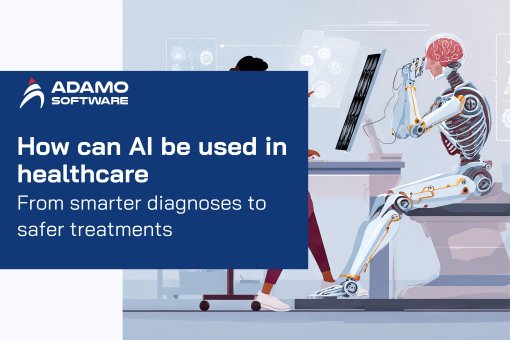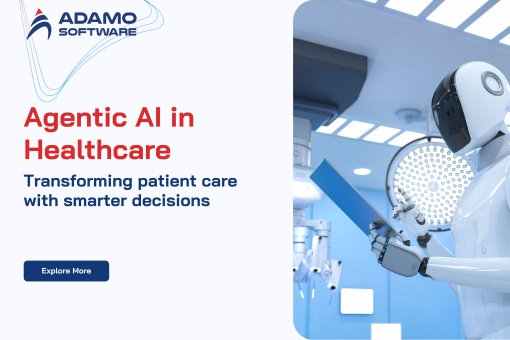Digital Therapeutics: Revolutionizing Healthcare with Innovative Treatments
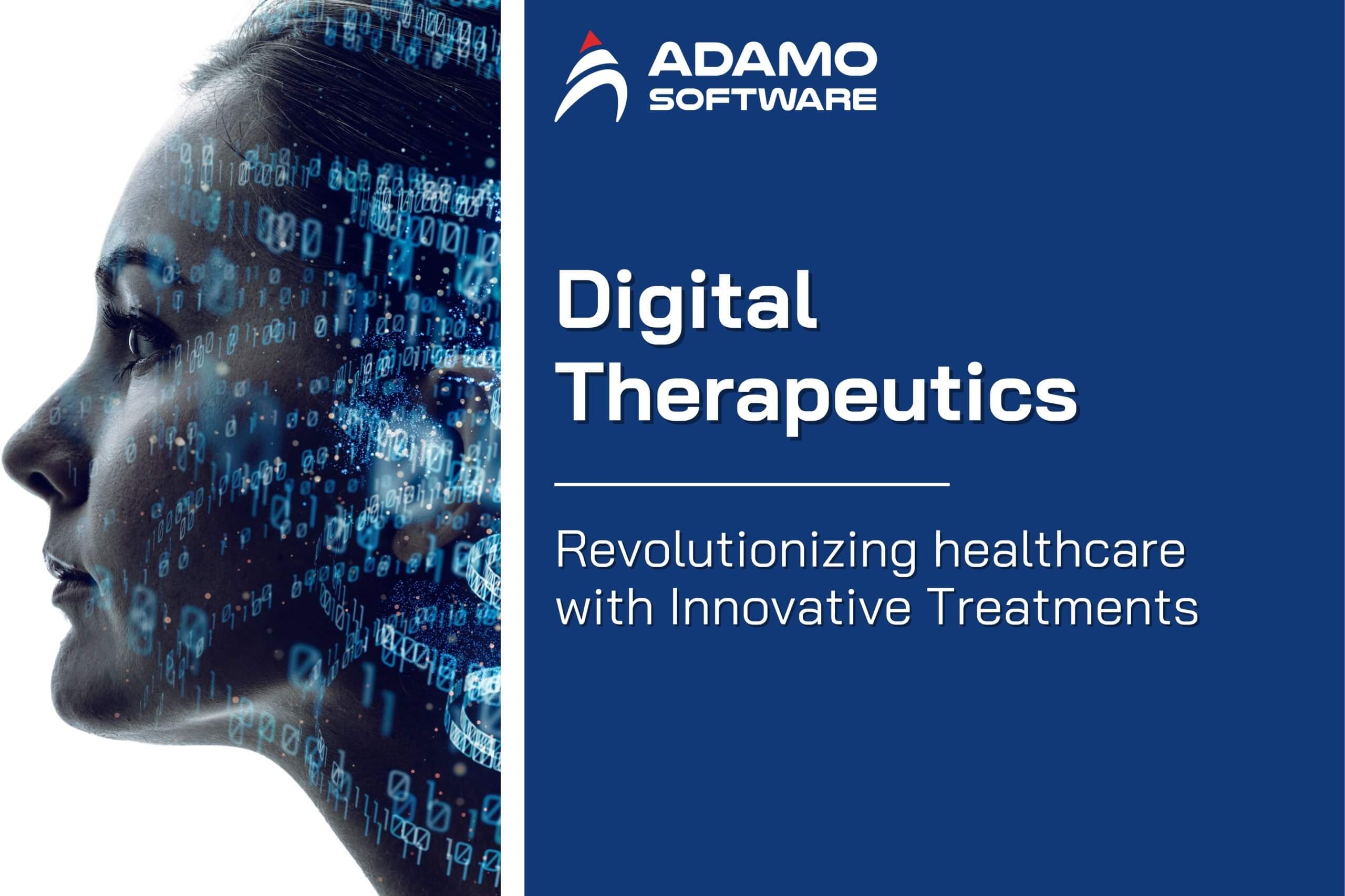
Learn how digital therapeutics improve global healthcare, overcome challenges, and revolutionize treatments with advanced technology and smart medical solutions.
The emerging digital therapeutic technologies (DTx) transform how people handle their healthcare needs. Software-based medical treatments through DTx platforms assist patients in disease prevention while helping them manage existing conditions or treat illnesses. DTx combines pharmaceutical properties with application-based technology instead of conventional medicine formulation.
Digital therapeutic solutions enable users to obtain safe, evidence-based treatment through mobile applications. Patients can get access to this app anywhere at any time. Through technology platforms, healthcare delivery acquires more effective capabilities. It provides customized support, monitors patient advancement, and delivers proven medical treatments. The healthcare providers hold the authority to write prescriptions for these medicines. This functions as conventional medical treatments to support patients with chronic illnesses, mental health issues, and various other health conditions.
The continuous growth of digital therapeutic solutions improves healthcare delivery efficiency and patient access to healthcare services. Digital treatments present healthcare advancements. They help improve patient care, though they bring ongoing difficulties to overcome. Digital therapeutics transform global healthcare by providing this piece with an evaluation of their global healthcare impact, benefits, challenges, and potential development paths ahead.
I. What is a digital therapeutic?
Digital treatments, known as DTx, are software applications that serve as medical treatments for disease prevention and management and treatment purposes. The distinction between digital therapeutic and other health apps exists through required clinical trials to demonstrate safety and effectiveness. The prescription power of healthcare providers extend to digital therapeutic products. This operates like standard medical prescriptions.
Technology provides digital therapeutic approaches for delivering individualized care to patients. Digital therapeutic software helps treat people with chronic diseases, mental health needs, and those undergoing rehabilitation. The treatments guide patients while monitoring their development and making alterations according to specific requirements. Digital treatments are different from standard pharmaceutical medication products because they do not require a pill or injection form. Digital therapeutics operate either through applications or interfaces with apps and smart devices or online programs.
Patients can access healthcare through digital therapeutics because these tools increase accessibility to medical services. The patient can use digital therapies at any location without any restrictions. People benefit greatly from digital therapies because they do not need frequent visits to physicians’ offices. Digital therapeutic systems let doctors access real-time patient data, which enables them to modify medical treatments appropriately.
Modern digital therapeutic applications continue developing because of technological advancements. New therapeutic approaches combined with patient health support emerge through digital treatments. Digital therapeutics demonstrate effectiveness, which makes them crucial additions to modern medical practices.
II. How do digital therapeutics work to transform Global Healthcare?
Healthcare is transforming because digital therapeutics provide medical treatment that is accessible while also being cost-effective and personalized. Such software-based treatments facilitate disease control through technology. This means they enable patients to track health improvements and access continuous support channels. People experience unrestricted access to healthcare through digital therapeutics because the system operates through apps linked to smart devices.
Digital therapeutics is a key health improvement mechanism that supports patients suffering from long-term illnesses worldwide. Patients with diabetes, heart disease, and Mental health disorders must receive prolonged surveillance and medical care. This is because their conditions need steady oversight. Patients using digital therapeutics maintain their health goals because the technology delivers personalized care programs and tracking features with automated reminder systems. Through patient data collection, doctors achieve better outcomes for treatment planning.
The affordability of healthcare increases when implementing digital therapeutic methods. Most individuals find it difficult to pay for regular doctor check-ups and costly prescription drugs. Digital therapeutic programs enable patients to get advanced medical care through reduced expenses. These therapeutic solutions decrease hospital attendance, thus lowering health costs for patients and healthcare organizations.
Digital therapeutic solutions connect patients who lack healthcare access with essential medical care. Residents across numerous global regions face severe barriers when accessing medical doctors with specialists. Mobile phones and internet connections enable remote populations to gain medical assistance from digital therapeutic services. Through this approach, healthcare reaches more patients beyond geographic restrictions.
Digital therapeutics expand global healthcare by delivering improved treatments at lower costs. They provide additional access to healthcare services to broader populations. Digital therapeutics play an important role in modern technological progress within upcoming medical practices.
Also read: Digital health platform development: A comprehensive guide
III. Benefits of Prescription Digital Therapeutics
Healthcare experienced a breakthrough when prescription digital therapeutics provided medical validation for various software-based treatments for diverse conditions. To become eligible for doctor prescriptions, medical applications classified as digital therapeutics must succeed in clinical assessments followed by regulatory approval steps. These treatments apply advanced technology, evidence-based treatment methods, and data analysis to provide customized healthcare to patients. The treatments function independently, and support established therapeutic practices to enhance patient recovery.
Digital therapeutics generate numerous advantages that benefit medical patients, their doctors, and healthcare systems. Through digital accessibility, treatment becomes more convenient, and healthcare professionals can manage chronic diseases effectively. Therefore, it lowers healthcare expenses. The following list explains the main advantages of digital therapeutics that are prescribed by doctors.
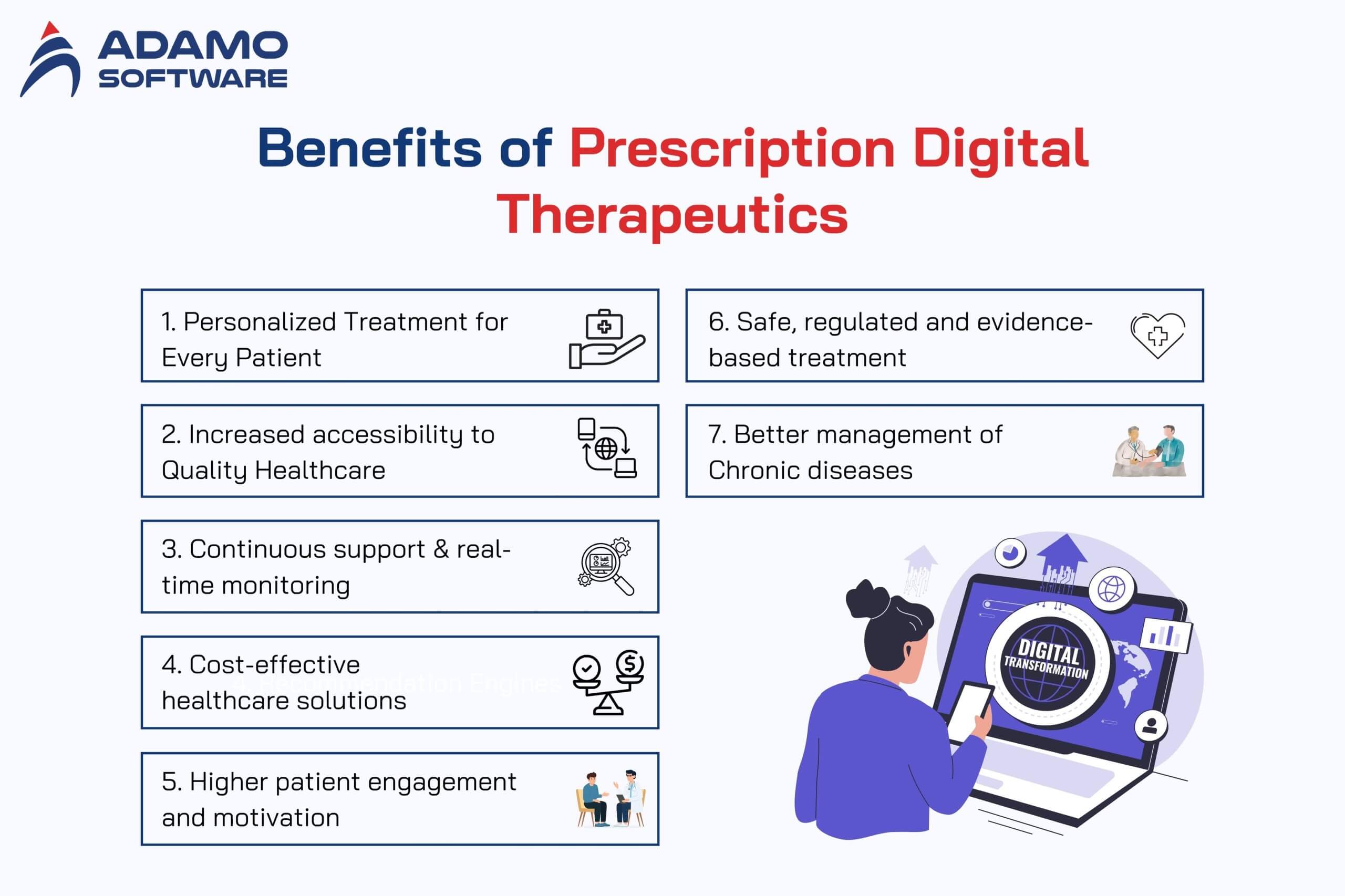
1. Personalized Treatment for Every Patient
Digital therapeutics deliver their most vital advantage through their capability to provide customized medical solutions. Digital therapeutics do not employ standard medication protocols because they adjust treatment plans to meet individual patient requirements.
- These therapies gather patient-reported information and sensor data along with artificial intelligence to make precise live adjustments to treatment methods.
- These solutions offer personalized healthcare services that deliver dietary recommendations with workout plans and cognitive behavioral training methods.
- Personalized care applications lead to improved therapy outcomes and enhanced patient clinical success.
2. Increased Accessibility to Quality Healthcare
The inability of millions worldwide to obtain proper healthcare emerges from place-based challenges, cost issues, and challenges related to transportation barriers. Patients currently benefit from Digital Therapeutics Apps, which connect them to remote healthcare solutions that operate on their mobile devices through an internet connection whenever they need.
- Medical care of high quality reaches patients who live in rural areas or do not have convenient health facilities through remote health services.
- The digital therapeutic approach provides care accessibility to patients who either need frequent medical checkups or costly medical treatments that are out of reach financially.
- Under this approach, expanded patient care accessibility becomes possible for everyone regardless of place of residence or financial situation.
3. Continuous Support and Real-Time Monitoring
The requirement of periodic doctor sessions for standard treatment proves challenging to patient compliance in maintaining their healthcare routine. Digital therapeutic devices give patients ongoing health monitoring capabilities and real-time feedback systems that promote better health control.
- A crucial feature of digital therapeutics includes automatic reminders about medications, lifestyle modifications, and therapy exercises.
- The system tracks patient symptoms with treatment progress so people can observe their ongoing health improvements.
- The remote monitoring system enables doctors to observe patient data to optimize treatment decisions through real-time data.
Continuous support between patients and their healthcare providers leads to fewer complications, better adherence to treatment plans, and decreased requirements for hospitalization.
4. Cost-Effective Healthcare Solutions
Many patients face financial challenges regarding obtaining healthcare due to increasing global medical expenses. Digital therapeutic platforms help healthcare costs stay low. They eliminate the requirement for pricy medicine consumption, hospital stays, nd lengthy medical care.
- The availability of treatment through digital platforms eliminates the requirement for patients to come in for direct healthcare consultations with doctors.
- Patients benefit from early preventive actions and ongoing supervising through digital therapeutics. This lowers healthcare expenses.
- More insurance programs with healthcare facilities now view digital therapeutics as solutions that decrease healthcare costs. Therefore, it provides greater accessibility to this treatment.
Medicare patients experience reduced healthcare expenses because combining digital therapeutics enhances long-term health management.
5. Higher Patient Engagement and Motivation
Patients abandon their treatment schedules because they lack motivation and comprehension of the plans. Combining interactive components, behavioral science elements, and gamification elements in digital therapeutics produces patient engagement.
- Patients obtain custom messages with rewards along with motivational challenges through the system.
- Part of digital therapeutics provides AI-powered coaching as a method for encouraging and guiding patients.
- Greater patient involvement due to digital therapeutics improves health results and patient treatment plan compliance.
Digital therapeutic platforms enhance patient involvement with treatment by creating rewarding sequences and interactive designs for better individual health participation.
6. Safe, Regulated, and Evidence-Based Treatment
Health and wellness applications cannot replace prescription digital therapeutics, which require clinical evidence and FDA or EMA and comparable regulatory body approval.
- Prescription digital therapeutic technologies must complete extensive clinical testing to demonstrate their efficacy and safety.
- The medical items undergo regulatory inspections to verify that they adhere to medical standards.
- Digital therapeutics is a reliable and trustworthy medical solution that satisfies doctors and patients.
These digital therapeutic platforms achieve medical approval like traditional drugs, which results in safety and effectiveness levels beyond what generic health applications can deliver.
7. Better Management of Chronic Diseases
Patients with diabetes, heart disease, chronic pain disorders, and mental health conditions need continuous medical attention. Digital therapeutic systems deliver systematic, continuous support that helps patients properly uphold their health conditions.
- Digital therapeutics measure blood sugar levels and deliver dietary instructions while reinforcing insulin intake to patients who have diabetes.
- Patients with chronic pain can receive physical exercise with relaxation therapy and pain monitoring instruments through these digital systems.
- Through digital therapeutic systems, patients receive CBT therapy coupled with meditation exercises and stress management tools for their mental wellness.
Through ongoing healthcare guidance, digital therapeutics enable patients to manage their health needs, thus minimizing the effect of ongoing diseases.
8. Reduced Burden on Healthcare Systems
Healthcare facilities have difficulty treating increasing patient numbers because they lack adequate space. Digital therapeutic solutions ease the healthcare service strain by giving patients the ability to obtain their treatments without leaving home.
- Early intervention and self-management capabilities of these programs help prevent patients from using hospital services needlessly.
- Digital platforms enable healthcare providers to maintain critical patient care as their professionals spend time remotely serving additional cases.
- Public health organizations with government bodies allocate funding to digital therapeutic platforms to enhance operational efficiency and decrease basic healthcare expenses.
- Digital therapeutics help relieve pressure on healthcare organizations. This leads to an improved sustainable medical infrastructure.
The healthcare industry is experiencing revolutionary changes because digital therapeutics offer treatments that are better tailored to individual needs while being more affordable and accessible. The system offers ongoing assistance. This increases patient attention levels while providing better control of managing chronic conditions.
The healthcare industry now utilizes digital therapeutics as essential medical tools that lower healthcare expenses and eliminate stress from medical facilities. Digital therapeutics will expand their role in healthcare development as technology progresses.
IV. Challenges of DTx
The field of healthcare experiences significant transformation thanks to innovative software-based medical therapies that treat different health conditions. The widespread use of these systems faces several obstacles that serve as adoption barriers. The difficulties that impact patients and doctors, healthcare providers, and policymakers occur simultaneously. The barriers to successful implementation must be clearly understood because they determine digital therapeutic development outcomes for future usage.
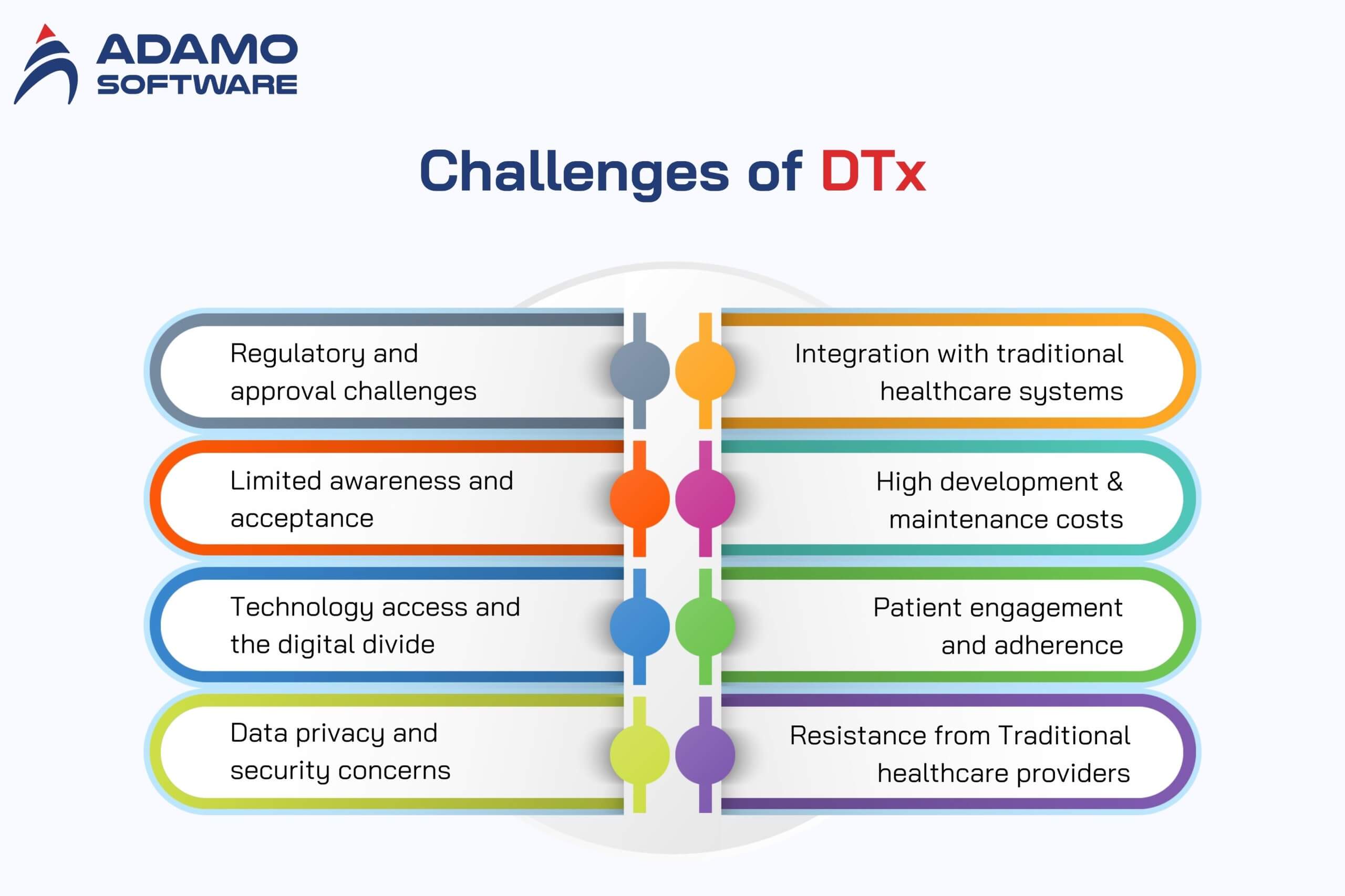
1. Regulatory and Approval Challenges
Medical programs labeled digital therapeutics need approval through comprehensive regulatory protocols before receiving authorization for patient use as medical treatments. The safety and effectiveness requirements of digital therapeutic regulations create delays that hinder their development and availability process.
- The continuous need for digital therapeutic updates extends the length of the approval process due to traditional medication protocols.
- Digital therapeutics companies face barriers to global approval. This is because each nation sets its regulatory requirements in a way that does not align properly with others.
- The absence of established rules for software-based treatment approaches leads to development uncertainty among software creators and healthcare providers.
Digital therapeutics face extra obstacles in their market deployment journey because of regulatory barriers that slow down their ability to help larger patient populations.
2. Limited Awareness and Acceptance
Most healthcare professionals with patients remain unacquainted with digital therapeutic approaches and their operational methods. Digital therapeutic adoption faces challenges because people do not understand their principles and functions.
- Doctors often avoid prescribing digital therapeutic products since their experience mainly lies with conventional medical therapies.
- The lack of understanding about digital therapeutic methods among patients causes them to doubt these treatments more than traditional medicine.
- Healthcare professionals require additional educational programs that would enable them to make confident digital therapeutic recommendations to patients.
- Digital therapeutics face difficulties in becoming standard medical treatments because doctors and patients need a better understanding of this approach.
3. Technology Access and the Digital Divide
Digital therapeutic systems are unavailable to certain patients who lack access to the required technological equipment. People from three specific demographics face particular obstacles in accessing digital therapeutic services. These groups include older adults with low income and residents from remote locations.
- Digital therapeutic effectiveness requires patients to have access to smartphones, tablets, and reliable internet connections, which certain patients lack.
- The digital interfaces challenge older patients because they make treatment plan adherence difficult for them.
- Language differences with reading ability affect the effectiveness with which patients engage with digital therapeutic systems.
Digital therapeutics must have solutions developed that will connect the digital divide to benefit everyone.
4. Data Privacy and Security Concerns
Digital therapeutic devices keep storing valuable health information that creates privacy and safety risks. The sharing and protection of individual health data provokes distress among patients and members of the healthcare sector.
- Patient data becomes vulnerable to cybersecurity threats because of inadequate digital therapeutic security measures.
- Patients avoid using digital therapeutics since they worry their health information could be shared unexpectedly.
- Companies building digital therapeutic solutions must follow complex regulations regarding data protection and face high implementation costs.
Data security must be robust to make digital therapeutics practical components of healthcare.
5. Integration with Traditional Healthcare Systems
Digital therapeutic solutions operate best when used with traditional medical care, even though their implementation into established healthcare systems faces adoption barriers.
- Hospitals and clinics throughout the healthcare sector do not possess digital therapeutic support capabilities.
- Doctors experience difficulties when implementing digital therapeutic tools because integration demands more time from their existing medical processes.
- Updating electronic health records systems with digital therapeutic information involves a complex upgrade process.
Digital therapeutics will fail to deliver maximum healthcare benefits when integration problems exist.
6. High Development and Maintenance Costs
Digital therapeutic development, research activities, software engineering, and regulatory compliance processes demand heavy financial investments.
- Corporate entities must perform extensive clinical testing of digital therapeutics to show their effectiveness, which demands substantial funding and lengthy timelines.
- Software development expenses increase through regular upgrades and enhancements since traditional medications need no post-production modifications.
- Difficulties in insurance coverage for digital therapeutics restrict the company’s potential to recover its investments.
The wide adoption of digital therapeutics depends on lowering production costs and enhancing insurance reimbursements.
7. Patient Engagement and Adherence
Digital therapeutics need active patient use according to their prescription for them to work effectively. Most patients encounter problems about staying engaged with their treatments and following the prescribed instructions.
- The reduction of clinical benefits occurs when patients discontinue digital therapeutic use during their early usage period.
- Patient commitment remains challenging because patients experience technical problems, lack of motivation, and external distractions.
- Some patients lack the necessary guidance and support, which makes them fail to use digital therapeutic devices properly.
Patient adherence to digital therapeutics grows when healthcare services focus on user-friendly design and powerful provider assistance.
8. Resistance from Traditional Healthcare Providers
Healthcare professionals display reservations about digital therapeutic applications when they lack an understanding of their advantageous aspects.
- Some physicians doubt that digital therapeutics will supplement medical services instead of acting as their substitute.
- Medical professionals resist using digital therapeutics because these treatments exist as software when they prefer physical medical approaches.
- Healthcare professionals require additional clinical research with real-world evidence to become convinced about the benefits of digital therapeutics.
Wider acceptance of digital therapeutics can be achieved when healthcare providers receive proper training and proof of their clinical success.
Digital therapeutic solutions deliver valuable advantages to health programs while dealing with implementation issues that affect their acceptance and operational success. To optimize the adoption and utility of digital therapeutics, regulatory standards need solutions, a heightened awareness of the technology with solutions to overcome data security issues and integration limitations.
Digital therapeutics need collaboration between healthcare systems developers and policymakers. This helps to solve the existing obstacles to maximizing their potential. The evolution of technology combined with solution development will drive digital therapeutics toward better healthcare transformation in present-day medical practices.
V. The Future of Digital Therapeutics
Digital therapeutic applications now transform how patients receive their medical care. The software-based therapies deliver secure, personalized, and effective medical care to treat multiple health conditions. Continuous technological progress will result in more powerful and accessible digital therapeutic solutions.
Digital therapeutics hold great promise because researchers expect advancements in artificial intelligence with data analytics and remote healthcare capabilities. Such innovations will serve more patients by delivering better outcomes at reduced healthcare expenses.
1. Expanding Treatment Options
Digital therapeutic solutions are already treating people with diabetes and those managing mental health disorders and experiencing chronic pain. Medical and disease applications for digital therapeutics continue developing into the future for additional medical conditions.
- Digital therapeutics developers intend to release three new therapeutic systems. They will treat neurological conditions, support cancer care, and manage respiratory diseases.
- Advanced mental health services incorporating individualized anxiety treatment along with depression treatment and PTSD therapy will be available through their enhanced programs.
- Real-time health monitoring through integrated wearable devices will be possible with digital therapeutics systems that adjust treatments according to patient progress.
The growing quantity of research studies will turn digital therapeutics into standard medical care options for multiple health conditions.
2. Artificial Intelligence and Machine Learning
Digital therapeutics will heavily depend on artificial intelligence technology for their future development. The extensive analysis of patient information by AI systems enables the production of customized healthcare programs.
- Digital therapeutic systems powered by artificial intelligence capability will modify treatment plans during active therapy based on patient results.
- Machine learning systems will predict what medical dangers exist while also giving advance notice of possible medical complications.
- Virtual assistants with AI capabilities will increase patient involvement through constant support availability.
AI improvements enable digital therapeutics to achieve higher levels of efficiency, thus making them better at providing treatments to patients.
3. Increased Adoption in Mainstream Healthcare
The demonstrated success in clinical trials will make digital therapeutics establish themselves as permanent healthcare tools. Healthcare providers, including doctors and hospitals with insurance organizations, will accept digital therapeutics as critical therapeutic solutions.
- The number of healthcare staff who can either prescribe or manage digital therapeutic programs will increase.
- Medical facilities will implement digital therapeutic solutions as part of their standard patient care strategies.
- The availability of digital therapeutic coverage by insurance providers will increase through expanded benefits, which will lower costs for patients.
Digital therapeutic access for more patients will expand through increased acceptance and lead to improved global health services.
4. Improved Patient Engagement and Adherence
Patient adherence remains a significant barrier for healthcare providers to ensure treatment plan compliance from patients. Digital therapeutics will develop their capabilities to engage patients while ensuring they adhere to their prescribed treatments in the future.
- Treatments will become more engaging through gamification elements, which include reward systems and performance monitoring mechanisms.
- Through AI-driven coaching systems, patients will get custom-made encouragement and professional advice.
- Digital therapeutics will become accessible to all age groups because user-friendly designs improve system usability.
The improved technology solutions will increase treatment compliance among patients while producing better health results.
5. Better Data Security and Privacy
For digital therapeutics to maintain their effectiveness, they must strengthen their security standards and privacy protection features while processing health-related data. System developers will concentrate on combining data security measures with user accessibility improvements to protect patient privacy.
- The use of blockchain technology enables medical data storage and protection.
- The enforcement of stricter data protection regulations will ensure digital therapeutics fulfill international security requirements.
- Patients will achieve better data control for sharing and usage purposes.
Better security measures will increase the trust levels that patients and healthcare providers have in digital therapeutic solutions.
6. Global Expansion and Accessibility
New strategies to increase digital therapeutic access worldwide will focus on underserved communities.
- The development of inexpensive digital therapeutic solutions will target nations having restricted access to healthcare funding.
- Having more translation options alongside cultural adaptations will enable digital therapeutics to serve various population groups.
- Nonprofits, with governments, plan to spend money on digital therapeutic solutions as part of their public health programs.
Digital therapeutics distributed to all people will lead to inclusive healthcare that delivers superior results.
Digital therapeutics hold numerous promising developments that shape their future trajectory. As AI technology evolves and patient interaction quality and system protection strengthen, digital therapeutic solutions will transform into the critical medical technology of contemporary times. Medical treatments available to the general population will lead healthcare toward personalized services at reduced costs with optimized results. Digital therapeutics represent the path forward that healthcare will follow beyond the current era.
VI. Take the advantage of Digital Therapeutics app with Adamo Software

Healthcare transformation comes from digital therapeutics, which deliver effective software-based medical treatments for different health conditions. The complete potential of this technology depends on business access to dependable, innovative digital solutions. By creating high-end digital therapeutic solutions, Adamo Software assists healthcare providers, startups, and organizations in developing specific medical treatment programs.
Customer-oriented digital therapeutics applications emerge from Adamo Software, which boosts patient involvement and therapeutic results. Healthcare software development team at Adamo Software delivers advanced, secure solutions that provide business customers with efficient, scalable healthcare services. Businesses that join forces with Adamo Software gain access to digital therapeutic solutions that enable them to provide improved healthcare services worldwide to patients.Contact us today!









